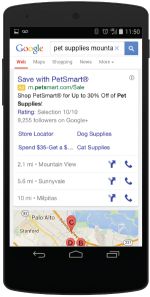©iStock.com/Noctiluxx
Search company Google has announced it will soon be rolling out AdWords developments to better measure in-store visits from the Estimated Total Conversions (ETC) tool.
In a bid to assist entrepreneurs together with targeting the increasingly complex paths to purchase that customers take, Google is currently letting advertisers link AdWords with My Business to get more insights on search campaigns.
Google clarified brick and mortar had a part to play by quoting eMarketer research that revealed 95 percent of sales take place in physical stores, when announcing the new AdWords feature on its own website.
Source of shop visits
Store visit the extra tools of conversion will reveal advertisers that campaigns and apparatus drive the most store visits. With this data, marketers can correct their ad creative, invest and bidding strategies.
 Office Depot has already run inventory-based advertisements to allow customers understand whether their community shop has specific products. The merchant used shop insights to allow it to understand the goods that drove the many visits.
Office Depot has already run inventory-based advertisements to allow customers understand whether their community shop has specific products. The merchant used shop insights to allow it to understand the goods that drove the many visits.
Elsewhere, animal retailer PetSmart analysed AdWords insights to discover a store visit was contributed to by 10-18 % of search advertising clicks. PetSmart now uses instructions and maps to help consumers find their way to stores.
Location and inventory information
Underlining the importance of location information the study of Google reported while 74% want to see the stock levels of a shop, how 70 % of customers have used advertising features like directions or the telephone .
To allay any fears that consumers may have about being monitored as they move between stores, Google worried that store visits have been estimated using aggregated, anonymised information from a sample group of consumers who have Location Background.
The updates to ETC will happen during the next few weeks, but to begin with the tools will only be made available to qualified advertisers in the united states.

